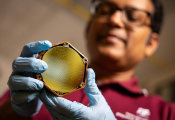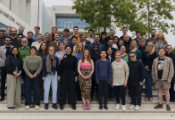Opening a Window Into the Quantum World
September 16, 2025 -- Oxford University physicists are simulating the strange, probabilistic world of quantum mechanics, opening the door to new innovations for superconductors, materials science, and quantum technologies.
It turns out that when you chill atoms to near absolute zero and suspend them in magnetic fields, the usual rules of matter no longer apply. Instead, the bizarre logic of quantum mechanics - where particles behave like waves and probabilities replace certainties- rule the day. But here at Oxford, researchers are not merely observing these strange phenomena, but engineering and controlling it with pioneering precision.
‘It’s a bit like building a wind tunnel for quantum physics,’ explains Erik Rydow, DPhil student in Oxford’s Ultracold Quantum Matter Lab. ‘You can simulate how an aircraft wing behaves on a computer, but to really understand it, you need a controlled experiment. We’ve built the quantum equivalent of that wind tunnel.’
Quantum systems can be notoriously hard to simulate because they don’t behave like the physical systems we experience day to day. In the classical world, if the starting conditions of a system are precisely the same each time, then the final result will be the same. But in quantum mechanics, particles can exist in more than one state at once. This means that simulating a quantum system in general does not give you a definite outcome: instead, it gives you a spread of probabilities for the different things that may happen.
‘You can think of it like rolling a dice,’ adds Erik. ‘In the classical world, if the starting conditions are exactly the same each time, then the dice will land in the same place. But in the quantum world, even if the starting state is exactly the same between rolls, the dice can land on different sides. This means you can’t say for certain what outcome will happen; you can only give a probability.’
Trying to capture all these possibilities quickly overwhelms even the world’s fastest supercomputers. With every extra particle added to the calculation, the number of states multiplies, dramatically increasing the possible outcomes and making the problem intractable. The Ultracold Quantum Matter research group in Oxford has a different approach. Rather than trying to calculate every outcome, researchers build quantum simulators: real, highly controlled experiments where the atoms themselves play out the quantum behaviour.
This capability rests on decades of innovations to trap and cool atoms. Using finely-tuned lasers and magnetic fields, a gas of rubidium atoms is chilled to near absolute zero; cold enough that tens of thousands of atoms all occupy the same quantum state. At such a low temperature, the behaviour of the atoms is determined by their quantum wavelike nature, and the different outcomes for identical particles can reveal the probabilities predicted by quantum mechanics. This creates an extraordinary laboratory for probing quantum effects that, until recently, were purely theoretical.
A hallmark of Oxford’s expertise is precision control. By manipulating atoms with radio frequencies, the team can separate them into ultrathin layers only a few microns apart with an exactness that is challenging to achieve with more standard protocols that use lasers. Uniquely to Oxford’s apparatus, these atoms can be precisely engineered into not just a single layer, but two. This enables researchers to capture extraordinary quantum ‘tunnelling’ effects, where atoms can be present in both layers at once, or flickering between them in ways that defy classical physics.
‘The ability to trap atoms and separate them into two distinct layers using radio frequencies is something Oxford specialises in,’ adds Erik. ‘It has taken years of development in our group to reach this point, but it is now yielding extraordinary new insights.’
Creating new phases of matter
As well as exploring exotic physics, understanding these quantum effects could help unlock a pivotal goal: next-generation superconducting materials that enable frictionless flow of electrons at higher temperatures.
In a recent study published in Nature Communications, the Oxford team were able to map out, for the first time, how their double-layer system changes under different conditions - a kind of ‘phase diagram’ for this new quantum material. What they saw was striking: when the two layers were brought close enough, quantum tunnelling between them helped the particles flow without friction, even at higher temperatures than expected for a single layer.
Normally, tiny whirlpools (known as vortices) would appear and disrupt this frictionless flow. However, the tunnelling between the layers effectively suppressed those disturbances, preserving the smooth, resistance-free movement.
‘While actual tunnelling of particles is not very frequent, the consequences are dramatic: it binds the layers into a single state with shared coherence, enabling frictionless flow across both layers. It effectively becomes a new phase of matter,’ says Dr Shinichi Sunami, a postdoctoral researcher of the group who supervised the project. Oxford’s state-of-the-art quantum simulator apparatus enables researchers to precisely control the separation and therefore quantum tunnelling rate between the layers, allowing them to investigate precisely how these phenomena invoke new properties.
Similar principles apply in advanced materials like bilayer graphene, where tiny shifts in alignment can dramatically change its properties. By directly observing how these transitions happen, quantum simulations are providing insights that no classical computer could calculate alone.
A platform for discovery
Here at Oxford, this is just the beginning. The same apparatus that allows researchers to validate theories can also explore uncharted territory: How do quantum systems evolve when cooled suddenly? How do entirely new phases of matter emerge in real time?
‘These are questions theory alone struggles to answer,’ says Erik. ‘But with our simulators, we can perform the experiment and watch events at the quantum level unfold. I feel extraordinarily lucky to be working on this for my DPhil research. There are so many other interesting phenomena we can explore with this unique apparatus.’




































